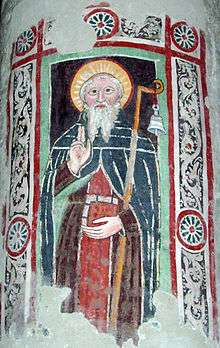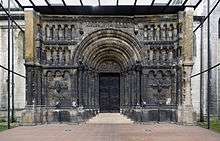Hiberno-Scottish mission
The Hiberno-Scottish mission was a series of missions and expeditions initiated by various Irish clerics and cleric-scholars who, for the most part, are not known to have acted in concert.[1]

There was no overall coordinated mission, but there were nevertheless sporadic missions initiated by Gaelic monks from Ireland and the western coast of Scotland, which contributed to the spread of Christianity and established monasteries in Britain and continental Europe during the Middle Ages. The earliest recorded Irish mission can be dated to 563 with the foundation of Iona by the Irish monk Saint Columba. Columba is said by Bede and Adamnán to have ministered to the Gaels of Dál Riada and converted the northern Pictish kingdoms.
Over the next centuries more missions followed and spread through Anglo-Saxon England and the Frankish Empire. Since the 18th and 19th centuries, these early missions were called 'Celtic Christianity', though aside from some idiosyncratic cultural features, this version was still orthodox and maintained relationships with the Holy See.[2]
The Latin term Scotti refers to the Gaelic-speaking people of Ireland and western Scotland. In early medieval times Ireland was known as "Éire" (Irish), "Hibernia" and "Scotia" (Latin). By the end of the 11th century it generally referred to the Kingdom of Scotland, the remainder of which had become Gaelicised in the preceding centuries, and from whence the name Scotland derives. Thus, the "Scot" missionaries who so influential in the early Church history of Germany included men from both present-day nations, but mainly from Ireland.[2]
Schottenklöster (German for "Scottish monasteries") is the name applied to the monastic foundations of Gaelic missionaries in Continental Europe, particularly to the Scottish Benedictine monasteries in Germany, which in the beginning of the 13th century were combined into one congregation whose abbot-general was the Abbot of the Scots monastery at Regensburg. Ireland's sobriquet "Island of Saints and Scholars" derives from this period, when scholars and missionaries from Ireland exerted great influence on Continental Europe.[2]
Columba to Columbanus (563-615)
Irish abbot and missionary Columba founded the abbey of Iona off the western coast of modern-day Scotland in 563. Following that was the foundation of Lindisfarne in 635 by the Irish monk, Aidan of Lindisfarne (later canonized). The missions continued throughout most Anglo-Saxon kingdoms during the following decades; the last pagan Anglo-Saxon king, Arwald of the Isle of Wight, was killed in battle in 686.
Columbanus was active in the Frankish Empire from 590, establishing monasteries until his death at Bobbio in 615. He arrived on the continent with twelve companions and founded Annegray, Luxeuil, and Fontaines in France and Bobbio in Italy.
During the 7th century the disciples of Columbanus and other Gaelic missionaries founded several monasteries in what are now France, Germany, Belgium, and Switzerland. The best known are: St. Gall in Switzerland, Disibodenberg in the Rhine Palatinate, St. Paul's at Besançon, Lure and Cusance in the Diocese of Besançon, Bèze in the Diocese of Langres, Remiremont Abbey and Moyenmoutier Abbey in the Diocese of Toul, Fosses-la-Ville in the Diocese of Liège, Mont Saint-Quentin at Péronne, Ebersmunster in Lower Alsace, St. Martin's at Cologne, the Scots Monastery, Regensburg, Vienna, Erfurt and Würzburg.
In Italy, Fiesole produced Saint Donatus of Fiesole and Andrew the Scot of Fiesole. Another early Schottenkloster was Säckingen in Baden, founded by the Irish missionary Fridolin of Säckingen who is said to have founded another at Konstanz. Other Hiberno-Scottish missionaries active at the time, predominantly in Swabia, were Wendelin of Trier, Kilian, Arbogast, Landelin, Trudpert, Pirmin (founded Reichenau abbey), Saint Gall (Abbey of St. Gall), Corbinian, Emmeram and Rupert of Salzburg.
After Columbanus (8th to 13th centuries)

Hiberno-Scottish activity in Europe continued after the death of Columbanus. There were monastic foundations in Anglo-Saxon England, the first in about 630 at "Cnobheresburgh", an unknown place in East Anglia but possibly Burgh Castle mentioned by Bede. Others such as Malmesbury Abbey, perhaps Bosham, and Glastonbury Abbey had strong Irish links. The profile of Iona declined, and from 698 until the reign of Charlemagne in the 770s, the Hiberno-Scottish efforts in the Frankish Empire were continued by the Anglo-Saxon mission – see Germanic Christianity.
Irish monks known as Papar are said to have been present in Iceland before its settlement from AD 874 onwards by the Norse. The oldest source mentioning the Papar is the Íslendingabók ("Book of the Icelanders"), between 1122 and 1133. Such figures are also mentioned in the Icelandic Landnámabók ("Book of Settlements", possibly going back to the early 12th century) which states that the Norse found Irish priests, with bells and crosiers, at Iceland at the time of their arrival.
Among the Irish monks who were active in Central Europe were two particularly important theologians, Marianus Scotus and Johannes Scotus Eriugena. Legends of Irish foundations are recorded in a Middle High German text known as Charlemagne and the Scottish [Irish] Saints (Shaw, 1981).
The rule of St. Columbanus, which was originally followed in most of these monasteries, was soon superseded by that of St. Benedict. Later Gaelic missionaries founded Honau in Baden (about 721), Murbach in Upper Alsace (about 727), Altomünster in Upper Bavaria (about 749), while other Gaelic monks restored St. Michel in Thiérache (940), Walsort near Namur (945), and, at Cologne, the Monasteries of St. Clement (about 953), St. Martin (about 980), St. Symphorian (about 990), and St. Pantaléon (1042).
Towards the end of the 11th and in the 12th century a number of Schottenklöster, intended for Irish monks exclusively, sprang up in Germany. About 1072, three monks, Marianus, Iohannus, and Candidus, took up their abode at the little Church of Weih-St-Peter at Regensburg (called Ratisbon in older literature). Their number soon increased and a larger monastery was built for them (about 1090) by Burgrave Otto of Regensburg and his brother Henry. This became the famous Scots Monastery of St. James in Regensburg, the mother-house of a series of other Schottenklöster. It founded the Abbeys of St. James at Würzburg (about 1134), St. Aegidius at Nuremberg (1140), St. James at Constance (1142), Our Blessed Lady at Vienna (1158), St. Nicolas at Memmingen (1168), Holy Cross at Eichstätt (1194), and the Priory of Kelheim (1231). These, together with the Abbey of St. James at Erfurt (1036), and the Priory of Weih-St-Peter at Ratisbon formed the famous congregation of the German Schottenklöster which was erected by Innocent III in 1215, with the Abbot of St. James at Ratisbon as abbot-general.
14th century onwards
In the 14th and 15th centuries most of these monasteries were on the decline, partly for want of Irish monks, and partly on account of great laxity of discipline and financial difficulties.
In consequence, the abbeys of Nuremberg and Vienna were withdrawn from the Irish congregation and repeopled by German monks in 1418. St. James's Abbey, Würzburg, was left without any monks after the death of Abbot Philip in 1497. It was then re-peopled by German monks and in 1506 joined the congregation of Bursfeld.
In 1595, however, it was granted to the Scottish congregation and occupied by Scottish monks until its suppression in 1803. The abbey of Constance began to decline in the first half of the 15th century and was suppressed in 1530. That of Memmingen also disappeared during the early period of the Protestant Reformation in the following century.
The Abbey of Holy Cross at Eichstatt seems to have ceased early in the 14th century. In consequence of the Protestant Reformation in Scotland many Scottish Benedictines left their country and took refuge in the Schottenklöster of Germany during the 16th century.
The Scottish monasteries in Ratisbon, Erfurt, and Würzburg again began to flourish temporarily, but all endeavours to regain the monasteries of Nuremberg, Vienna, and Constance for monks of Scottish nationality failed.
In 1692, Abbot Placidus Flemming of Ratisbon reorganized the Scottish congregation which now comprised the monasteries of Ratisbon Regensburg, Erfurt, and Würzburg, the only remaining Schottenklöster in Germany. He also erected a seminary in connection with the monastery at Ratisbon.
But the forced secularization of monasteries in 1803 put an end to the Scottish abbeys of Erfurt and Würzburg, leaving St. James's at Ratisbon as the only surviving Schottenkloster in Germany. Since 1827 this monastery was again permitted to accept novices but the number of its monks dwindled down to two capitulars in 1862.
There being no hope of any increase, Pope Pius IX suppressed this last Schottenkloster in his brief of 2 September 1862. Its revenues were distributed between the diocesan seminary of Ratisbon and the Scots College at Rome.
See also
References
- Flechner, Roy; Meeder, Sven, eds. (2016). The Irish in Early Medieval Europe: Identity, Culture and Religion. London: Palgrave Macmillan. pp. 231–41. ISBN 9781137430595.
- Ott, Michael (1912). "Schottenklöster". The Catholic Encyclopedia. 13. New York: Robert Appleton Company. Retrieved 19 February 2013.
Further reading
- Bowen, E. G. (1977). Saints, Seaways and Settlements in the Celtic Lands. Cardiff: University of Wales Press. ISBN 0-900768-30-4.
- Shaw, Frank, ed. (1981). Karl der Große und die Schottischen Heiligen. Nach der Handschrift Harley 3971 der Britischen Bibliothek London [Karl the Great and the Scottish Saints. After the manuscript Harley 3971 in the British Library (London)]. Deutsche Texte des Mittelalters [German Texts of the Middle Ages] (in German). LXXI. Berlin (DDR): Akademie-Verlag.
External links
- Crawford, Barbara (ed.), Scotland In Dark Age Britain (St Andrews, 1996)
- Original Catholic Encyclopedia text of this article
- https://www.academia.edu/36649005/THE_WHEN_WHY_and_WHEREFORE_OF_SCOTLAND
![]()